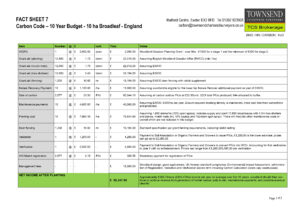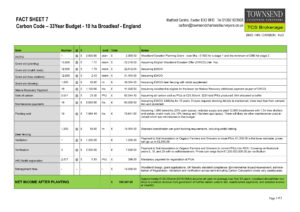Woodland Carbon
The Woodland Carbon Code (WCC) is the Government approved voluntary standard for UK woodland creation projects. It allows the landowner to verify and trade the carbon captured by the new woodland. It is administered by the Forestry Commission. The WCC is used to verify carbon sequestering projects throughout the UK with ongoing projects in England, Scotland, Wales and Northern Ireland. Each region provides differing support and grants for establishment of woodland in addition to the Woodland Carbon Code. Sites in England also have access to the Woodland Carbon Guarantee (WCG) which allows the selling of units to the Government.
Carbon is sequestered or ‘captured’ by woodland and measured in the form of the Woodland Carbon Units (WCU). This term is used to represent the amount of carbon dioxide removed by a certain amount of trees per year. A WCU represents a tonne of carbon dioxide captured in verified woodland which can then be purchased by companies to offset emissions or to claim carbon neutrality for the business. The Forestry Commission reports that landowners with new woodlands which meet the standards set out in the WCC initially sold carbon upfront to companies for between £5 and £15 / tCO2 however this was before the latest Woodland Carbon Guarantee auction resulted in average of £23.70/WCU. A new native woodland can capture 300-400 tonnes of CO2 equivalent per ha by 2050.
A business wanting to offset its future emissions may also purchase a Pending Issue Unit (PIU) which is in effect the future deliverance of a predicted WCU after a period of time. Whilst this cannot be used to offset UK-based emissions until a WCU is verified, it does allow a business to plan for offsetting future emissions. The WCC provides the standard for verification of WCUs, and this allows a purchaser assurance that any units purchased are actually providing the carbon capture they are paying for. The WCC requires woodland to be re-checked every 10 years.
UK Woodland Creation Grants
1. England Woodland Creation Offer (EWCO)
This is a grant to support the creation of new woodland, run by the Forestry Commission. It offers payments for capital items, including each tree planted, at a payment rate the Forestry Commission believes will cover 100% of costs. The Offer also provides “bolt-on” payments for a range of perceived benefits new woodlands may provide, such as expanding existing native woodlands, reducing flooding, or providing public access. It also provides a £200/ha pa payment for woodland maintenance in the ten years following establishment.
2. Scottish Government Forestry Grant Scheme
The Forestry Grant Scheme offers support for the creation of new woodland and the sustainable management of existing woodland in Scotland. There are eight categories of support options which include among others: planting, woodland protection and harvesting. There is grant support of up to £3,600/ha for initial planting and £624/ha annual maintenance for 5 years depending on woodland type and location. Agroforestry systems with 200 trees/ha can receive capital grants of up to £1,860/ha with £48/ha annual maintenance for 5 years.
3. Wales – The Woodland Investment Grant (TWIG) Scheme/Glastir Woodland Creation
For 2021/2022, TWIG provides 100% funding with the maximum grant award per application up to £250,000 and a minimum of £10,000. Glastir Woodland Grants also provide for the creation, management, and restoration of woodland in Wales. Glastir works on a per hectare basis, providing £4,500 under its highest-paying “woodlands for carbon” subcategory. It also offers a £60/ha pa maintenance payment for 12 years following creation, and a further £350/ha pa payment, also over 12 years, for income foregone from agricultural use for BPS claimants.
4. Northern Ireland – Small Woodland Grant Scheme/ Forest Expansion Scheme/Woodland Investment Grant
The Small Woodland Grant Scheme is specifically for new native woodland planting of 0.20 hectares and larger. The Forest Expansion Scheme is for new woodland planting of 3 hectares and larger. All woodlands that comply with the UK Forestry Standard are eligible for support. Successful applicants will receive up to 100% of eligible establishment costs and where eligible annual premia for a 10-year period. Payments include:
- Establishment grant of £2,925/ha covering initial preparation, trees (from a defined list), labour, weeding, maintenance, monitoring and protection. 80% of this grant (£2,340/ha) will be claimed in Year 1 and the remaining 20% (£585/ha) will be claimed in Year 5.
- Annual premia: This is an area-based payment of £3,500 /ha (10 annual payments x £350/ha) for woodland creation on agricultural land. The grant is eligible in Years 1- 10. These are payments for income foregone to cover loss of income compared to agricultural production. The grant rate may be subject to a periodic review.
- Stock fence grant: A payment rate of £6/m for new stock fencing. This is based on a standard specification. 100% of this grant will be claimed in Year 1.
English Woodland Carbon Guarantee
In England, the Government’s Woodland Carbon Guarantee (WCG) aims to support and encourage the planting of new woodland for carbon capture, there is no similar option for the other UK regions at present. This scheme guarantees that a landowner will be able to sell their WCUs to the Government for a pre-agreed price every 5 or 10 years up to 2055/56. One would still have the option to sell via the open market should prices rise above the pre-agreed price but would retain the security of a guaranteed minimum price from the Government going forward. Being accredited under the WCC is a requirement to be eligible for the Government’s WCG. The value of the WCU is determined via reverse auction before a contract with the Government is agreed for the option. The results have ranged from £17.31 to £24.11 per WCU.
Under Grazed Low Density New Woodland
It is possible to use an agroforestry system to generate WCUs without taking land out of agricultural production. In this instance grazing would be combined with low density woodland to gain three sources of income including the current BPS payments. Care is needed however with agricultural use in respect to the Forestry Commission as this could be a breach of their funding rules.
Example Budgets
A series of budgets estimating costs and returns for various sized woodland projects ranging from 10 ha to 100ha for all regions are set out in Woodland Creation and Carbon Budgets.

Trading Woodland Carbon Credits
- Woodland Creation:
- We can advise on establishing woodland (including site selection, design, carbon sequestering calculations, applying for grants based on the relevant regional location e.g. English Woodland Creation Offer, The Forestry Grant Scheme, Glastir Woodland Creation, Forest Expansion Scheme, HS2 Woodland Fund etc.) that is approved by the WCC, and the validation and verification process.
- For those looking to purchase land for woodland creation we act as a purchaser’s agent, finding on- and off-market sites depending on where and what type of woodland project you want to establish. This includes initial desktop and site surveys. We have a register of sites available and clients looking to buy.
- We have a register for trading woodland carbon units including Pending Issuance Units if you are considering taking advantage of the new carbon market.
- Purchasing Carbon Units
- We are registered as an official trader of woodland carbon with IHS Markit.
Woodland Carbon Credits Value
The most recent Woodland Carbon Guarantee auction, at the time of writing, closed in May 2022 and averaged £23.70 per unit among winning bids. Auction results so far have ranged from £17.31 to £24.11 per unit since the auctions started. This was not on the open market however and as a relatively young market with increasing demand, the prices are expected to increase. PIUs have been changing hands on the open market at between £15-20 and WCUs at £25-30.
What we can do for you:
Woodland Creation:
- We can advise on establishing woodland (including site selection, design, carbon sequestering calculations, applying for grants based on the relevant regional location e.g. English Woodland Creation Offer, The Forestry Grant Scheme, Glastir Woodland Creation, Forrest Expansion Scheme, HS2 Woodland Fund etc.) that is approved by the WCC, and the validation and verification process.
- For those looking to purchase land for woodland creation we act as a purchaser’s agent, finding on- and off-market sites depending on where and what type of woodland project you want to establish. This includes initial desktop and site surveys. We have a register of sites available and clients looking to buy.
- We have a register for trading woodland carbon units including Pending Issuance Units if you are considering taking advantage of the new carbon market.
Purchasing Carbon Units
- We are registered as an official trader of woodland carbon with IHS Markit.
- For our user guide on purchasing carbon units see here.
| If you are thinking of selling Pending Issuance Units or Carbon Units, whether under the Woodland Carbon code, Peatland Code, upcoming Soil Carbon code or even through a private sector measurement system, we advise you to first consider the likely future requirement for your business to become carbon neutral. You may in future require carbon offsets for your own use, and may make a net loss if you sell the carbon sequestered on your own holding only to buy further offsets from elsewhere. | ||

Hugh Townsend
FRICS. FCIArb. FAAV.
01392 823935
enquiries@townsendcharteredsurveyors.co.uk

Alasdair Squires
BA(Hons).
01392 823935
enquiries@townsendcharteredsurveyors.co.uk
